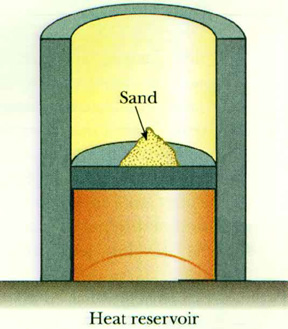

Heat Engines, Entropy, & the Second Law
Reversible and Irreversible Processes
Drop a glass and watch it break. If we run a video of that backward we will surely know the difference. Some processes are clearly irreversible -- like the shattering glass.
An example of an irreversible process in a "thermodynamic situation" could be a gas and a vacuum separated by a barrier -- like a membrane of aluminum foil -- as sketched here. If the barrier is broken the gas expands to fill the entire container. This sudden expansion into the vacuum does no work. The insulation prevents heat exchange. The gas molecules have the same velocity as before the break in the barrier so the temperature remains the same.
While we could argue that any or all processes are irreversible, we can approach reversible processes. One example of a reversible process could be a quasi-static expansion of a gas. We will let it expand slowly enough that all of the gas is always very close to an equilibrium temperature.

Return to ToC (c) Doug Davis, 2002; all rights reserved